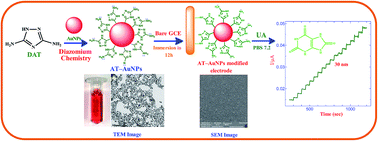Formation of heteroaromatic diazonium grafted layers on gold nanoparticles and their electrocatalytic activity towards an important purine derivative†
Abstract
We wish to report a spontaneous grafting of heteroaromatic aminotriazole groups at the surface of gold nanoparticles (AuNPs) by the reduction of in situ generated aminotriazole diazonium cations (ATD) in an aqueous medium. The aminotriazole layer at the surface of the AuNPs (AT-AuNPs) was characterized by UV-visible spectroscopy, high resolution-transmission electron microscopy (HR-TEM), X-ray diffraction, FT-IR spectroscopy, X-ray photoelectron spectroscopy (XPS) and surface-enhanced Raman spectroscopy (SERS). The absence of characteristic peaks for the diazonium group at 403.8 and 405.1 eV in the XPS confirms the reduction of the aminotriazole diazonium cations at the surface of the AuNPs. SERS shows the presence of an Au–C bond at 433 cm−1 on AT-AuNPs, which suggests the spontaneous grafting of an aminotriazole group on the AuNPs. Interestingly, the aminotriazole grafted AuNPs (AT-AuNPs) showed greater stability than the AuNPs grafted with other diazonium cations. Furthermore, the AT-AuNPs were self-assembled on both glassy carbon (GC) and indium tin oxide (ITO) electrodes (AT-AuNPs modified electrode) and were characterized by cyclic voltammetry, impedance spectroscopy and scanning electron microscopy. The AT-AuNPs modified electrode was successfully utilized for the sensitive determination of an important purine derivative, uric acid (UA). Using amperometry, detection of 30 nM UA was obtained. The current responses of UA increased linearly while increasing their concentrations from 3.0 × 10−8 to 1 × 10−4 M and the detection limit was found to be 3 × 10−11 M (S/N = 3). The practical application of the modified electrode was demonstrated by determining the concentration of UA in human blood serum and urine samples.


 Please wait while we load your content...
Please wait while we load your content...